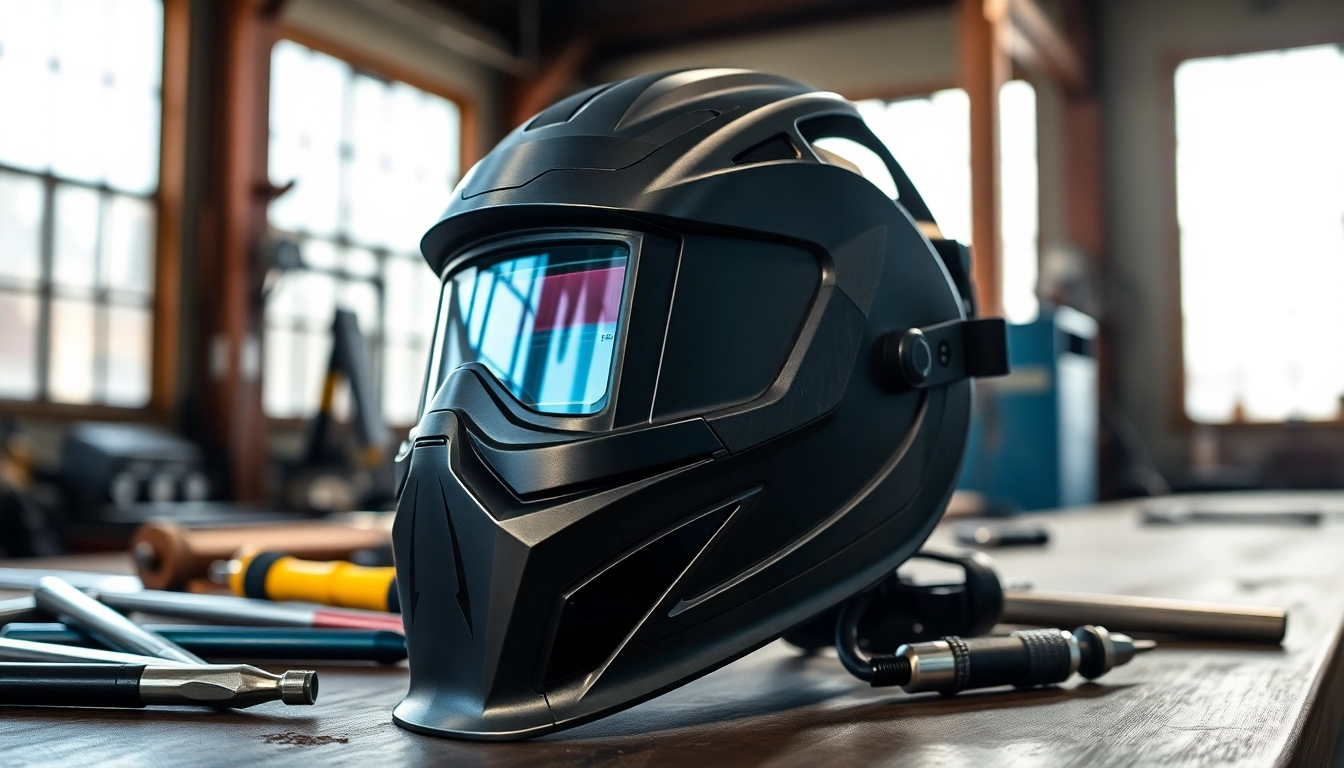Understanding the Importance of a Welding Mask
Welding is a process that involves intense heat and molten metals, which can create numerous hazards for those who work in this field. One of the most critical pieces of equipment for any welder is the welding mask, also known as a welding helmet. It serves as a protective barrier between the welder and the adverse effects of welding operations, such as UV radiation, sparks, and debris. Establishing an understanding of why a welding mask is indispensable is crucial for both novice and experienced welders alike.
What is a Welding Mask?
A welding mask is designed to protect the face, neck, and eyes of the welder. Typically, it consists of a helmet-like frame that securely fits over the head, featuring a clear visor or display that can darken automatically when the welding arc is initiated. This feature is essential as it shields the welder’s eyes from the intense brightness of the arc, which can cause permanent vision damage without adequate protection.
Key Features to Look For
- Auto-Darkening Filter: This feature allows the lens to adjust rapidly to the light from the welding arc, providing a clear view when not welding and protecting against harmful light when engaged.
- Comfort and Fit: A well-designed mask should fit snugly without being overly tight, allowing for comfort during long periods of use.
- Weight: Lightweight materials are preferable as they reduce fatigue during extended use.
- Variable Shade Settings: The ability to adjust the shade of the lens according to the welding method being used enhances safety and visibility.
- Additional Protection: Features such as face shields and flame-resistant materials can provide extra safety measures.
Benefits of Wearing a Welding Mask
The benefits of wearing a welding mask extend beyond personal comfort. First and foremost, it protects welders from severe eye injuries, which are a common risk due to the bright light generated during welding. Additionally, welding masks prevent exposure to harmful UV and infrared radiation that can cause skin damage and welders’ flash—an extremely painful eye condition caused by overexposure to UV rays. Furthermore, a high-quality welding mask can enhance productivity; by providing clear visibility and reducing fatigue, welders can work more efficiently.
Types of Welding Masks Available
When exploring different welding masks, it is essential to understand that they come in various types, each designed for specific applications and preferences.
Auto-Darkening Welding Masks
Auto-darkening welding masks are increasingly popular due to their ability to adjust the lens’s shading automatically in response to intense light. This innovative technology is particularly advantageous for welders who switch between different welding techniques frequently. They provide the benefit of excellent visibility and protection without requiring manual lens changes during jobs.
Passive Welding Masks
Passive welding masks feature fixed lenses that do not change shade automatically. While they are generally less expensive than their auto-darkening counterparts, they can be limiting as welders often need to flip the mask up or down to check their work when not welding. However, passive masks are highly durable and can be suitable for beginner welders who are just starting their journey in the welding craft.
Specialized Welding Masks
Some masks are tailored for specific types of welding, such as TIG, MIG, or plasma welding. These specialized masks may include unique features such as increased viewing areas, enhanced air circulation, or specialized filters to deal with specific light spectrums emitted during particular welding processes. Choosing a specialized mask can lead to better results depending on the welding application.
How to Choose the Best Welding Mask
Selecting the right welding mask is crucial for ensuring safety and enhancing the welding experience. Here are some tips on how to make an informed choice.
Assessing Your Welding Needs
Begin by evaluating your specific welding requirements. Consider the types of welding you will be performing whether it be MIG, TIG, or stick welding, as each method can produce different levels of light and heat. Once you identify your needs, you can narrow your options to masks that are best suited for those tasks.
Price vs. Quality Considerations
In the welding industry, you often get what you pay for. While budget considerations are important, investing in a quality welding mask is critical to safety and effectiveness. Lower-priced models may lack essential features such as auto-darkening technology, proper shade ratings, and comfort designs, potentially resulting in higher costs due to injuries or inefficiencies over time. Evaluate the features that are most critical to your work and weigh them against your budget constraints.
Brand Recommendations and Reviews
Researching different brands and reading user reviews can provide valuable insights into which welding masks are most reliable and widely recommended. Brands like Miller, Lincoln, and ESAB are known for their quality and durability, frequently receiving high praise from professionals within the industry. Look for customer feedback regarding comfort, functionality, and long-term performance.
Maintaining Your Welding Mask
Proper maintenance of your welding mask can significantly extend its lifespan and ensure that it remains effective throughout its use.
Cleaning and Storage Practices
After each use, it is essential to clean your welding mask to remove any contaminants, such as spatter, dust, and welding fumes. Use a soft, damp cloth for cleaning the exterior and a lens cleaning solution for the visor section to prevent scratching. For storage, ensure that your mask is kept in a dry, cool place away from direct sunlight to prevent degradation of materials.
Common Repairs and Maintenance Tips
Check your welding mask for signs of wear and tear regularly. If the auto-darkening feature fails or the lens becomes heavily scratched, these components can often be replaced rather than investing in a completely new unit. Refer to the manufacturer’s guidelines for specific repair instructions and maintenance schedules.
When to Replace Your Welding Mask
Your welding mask should be replaced when visible damage occurs, such as cracks in the lens, persistent malfunction of the auto-darkening feature, or significant wear on the headgear. Typically, it is prudent to consider replacement every three to five years, depending on usage, as material fatigue may undermine protective capabilities. Always prioritize safety and functionality over cost-saving measures.
Welding Mask Safety Standards
Understanding relevant safety standards is vital for any welder to ensure they are using appropriate protective equipment when working.
Understanding ANSI and ISO Standards
The American National Standards Institute (ANSI) and the International Organization for Standardization (ISO) set rigorous safety standards that welding masks must meet to ensure the highest levels of protection. For welding helmets, look for compliance with ANSI Z87.1 standards, which outline the minimum safety requirements for eye and face protection. Masks that meet these standards are tested for impact and optical quality, giving users more reassurance concerning performance and safety.
Compliance and Certification Information
When purchasing a welding mask, look for certification labels that indicate compliance with ANSI and ISO standards. Certified products will typically display a marking on the product or packaging. This verification provides necessary assurances regarding the mask’s protective capabilities.
Importance of PPE in Welding
Personal Protective Equipment (PPE) is vital in welding as it not only protects against immediate hazards but also guards against long-term health issues. In addition to welding masks, appropriate PPE includes gloves, aprons, and appropriate attire. Utilizing comprehensive protective gear will help prevent workplace injuries and illnesses associated with welding fumes and other environmental hazards.


